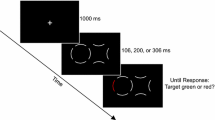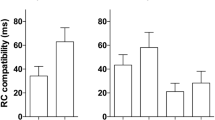Abstract
The modulated visual pathway (MVP) hypothesis attempts to explain a range of differences observed in the processing of objects in the proximal as compared to the distal region of the hand. However, there has been no account of how ‘hand proximity’ interacts with task relevance within the MVP framework. In the present study, we used a visual search task to test whether the task relevance of a unique feature (motion in Expt. 1, and color in Expt. 2) influences its processing with respect to the hand. The feature was either relevant (Expt. 1a and 2a) or irrelevant (Expt. 1b and 2b) to the search task. The hand proximity effect was observed only in the experiments in which the unique feature was task irrelevant. However, the effect of hand proximity was overridden when the unique feature was predictive of the target location. We propose that it is difficult to accomplish active distractor rejection of magnocellular features near the hand. Similarly, there is improved active distractor rejection of parvocellular features in the distal region of the hand. Overall, the results suggest that processes involving active distractor rejection may drive the attentional effect of hand proximity.




Similar content being viewed by others
References
Abrams RA, Davoli CC, Du F, Knapp WH, Paull D (2008) Altered vision near the hands. Cognition 107(3):1035–1047
Bacon WF, Egeth HE (1994) Overriding stimulus-driven attentional capture. Percept Psychophys 55(5):485–496
Brainard DH (1997) The psychophysics toolbox. Spat Vis 10(4):433–436
Cosman JD, Vecera SP (2010) Attention affects visual perceptual processing near the hand. Psychol Sci 21(9):1254–1258
Derrington AM, Lennie P (1984) Spatial and temporal contrast sensitivities of neurones in lateral geniculate nucleus of macaque. J Physiol 357:219–240
Dosso JA, Kingstone A (2018) The fragility of the near-hand effect. Collabra: Psychol 4(1).
Garza JP, Strom MJ, Wright CE, Roberts RJ, Reed CL (2013) Top-down influences mediate hand bias in spatial attention. Atten Percept Psychophys 75(5):819–823
Goodhew SC, Gozli DG, Ferber S, Pratt J (2013) Reduced temporal fusion in near-hand space. Psychol Sci 24(6):891–900
Goodhew SC, Fogel N, Pratt J (2014) The nature of altered vision near the hands: evidence for the magnocellular enhancement account from object correspondence through occlusion. Psychon Bull Rev 21(6):1452–1458
Gozli DG, West GL, Pratt J (2012) Hand position alters vision by biasing processing through different visual pathways. Cognition 124(2):244–250
Graziano MSA, Cooke DF (2006) Parieto-frontal interactions, personal space, and defensive behavior. Neuropsychologia 44(6):845–859
Graziano MS, Gross CG (1993) A bimodal map of space: somatosensory receptive fields in the macaque putamen with corresponding visual receptive fields. Exp Brain Res 97(1):96–109
Graziano MS, Yap GS, Gross CG (1994) Coding of visual space by premotor neurons. Science 266(5187):1054–1057
Holmes NP, Spence C (2004) The body schema and multisensory representation(s) of peripersonal space. Cogn Process 5(2):94–105
Huffman G, Gozli DG, Welsh TN, Pratt J (2015) Hand position influences perceptual grouping. Exp Brain Res 233(9):2627–2634
Kelly SP, Brockmole JR (2014) Hand proximity differentially affects visual working memory for color and orientation in a binding task. Front Psychol 5:318
Leber AB, Kawahara J-I, Gabari Y (2009) Long-term abstract learning of attentional set. J Exp Psychol Hum Percept Perform 35(5):1385–1397
Livingstone M, Hubel D (1988) Segregation of form, color, movement, and depth: anatomy, physiology, and perception. Science 240(4853):740–749
Reed CL, Grubb JD, Steele C (2006) Hands up: Attentional prioritization of space near the hand. J Exp Psychol Hum Percept Perform 32(1):166–177
Sawaki R, Luck SJ (2011) Active suppression of distractors that match the contents of visual working memory. Visual Cognit 19(7):956–972
Sawaki R, Luck SJ (2014) How the brain prevents and terminates shifts of attention. In Cognitive electrophysiology of attention (pp. 16–29).
Serences JT, Yantis S, Culberson A, Awh E (2004) Preparatory activity in visual cortex indexes distractor suppression during covert spatial orienting. J Neurophysiol 92(6):3538–3545
Sunny MM, von Mühlenen A (2011) Motion onset does not capture attention when subsequent motion is “smooth”. Psychon Bull Rev 18(6):1050–1056
Sunny MM, von Mühlenen A (2014) The role of flicker and abrupt displacement in attention capture by motion onsets. Atten Percept Psychophys 76(2):508–518
Taylor JET, Gozli DG, Chan D, Hufman G, Pratt J (2015) A touchy subject: advancing the modulated visual pathways account of altered vision near the hand. Transl Neurosci 6:1–7
Thomas T, Sunny MM (2017) Slower attentional disengagement but faster perceptual processing near the hand. Acta Physiol (Oxf) 174:40–47
Tseng P, Bridgeman B (2011) Improved change detection with nearby hands. Exp Brain Res 209(2):257–269
Vatterott DB, Vecera SP (2012) Experience-dependent attentional tuning of distractor rejection. Psychon Bull Rev 19(5):871–878
Zehetleitner M, Goschy H, Müller HJ (2012) Top-down control of attention: It’s gradual, practice-dependent, and hierarchically organized. J Exp Psychol Hum Percept Perform 38(4):941
Acknowledgements
The present research is supported by a PhD Research Fellowship from the University Grants Commission and IIT Gandhinagar to Tony Thomas.
Author information
Authors and Affiliations
Corresponding author
Ethics declarations
Conflict of interest
We are not aware of any conflicts of interest regarding the research reported in the manuscript. Also, we have neither submitted to nor published in any other journal this work or any other manuscript related to this work.
Additional information
Communicated by Melvyn A. Goodale.
Publisher's Note
Springer Nature remains neutral with regard to jurisdictional claims in published maps and institutional affiliations.
Rights and permissions
About this article
Cite this article
Thomas, T., Sunny, M.M. Diminished distractor exclusion for magnocellular features near the hand. Exp Brain Res 238, 761–770 (2020). https://doi.org/10.1007/s00221-020-05752-8
Received:
Accepted:
Published:
Issue Date:
DOI: https://doi.org/10.1007/s00221-020-05752-8




